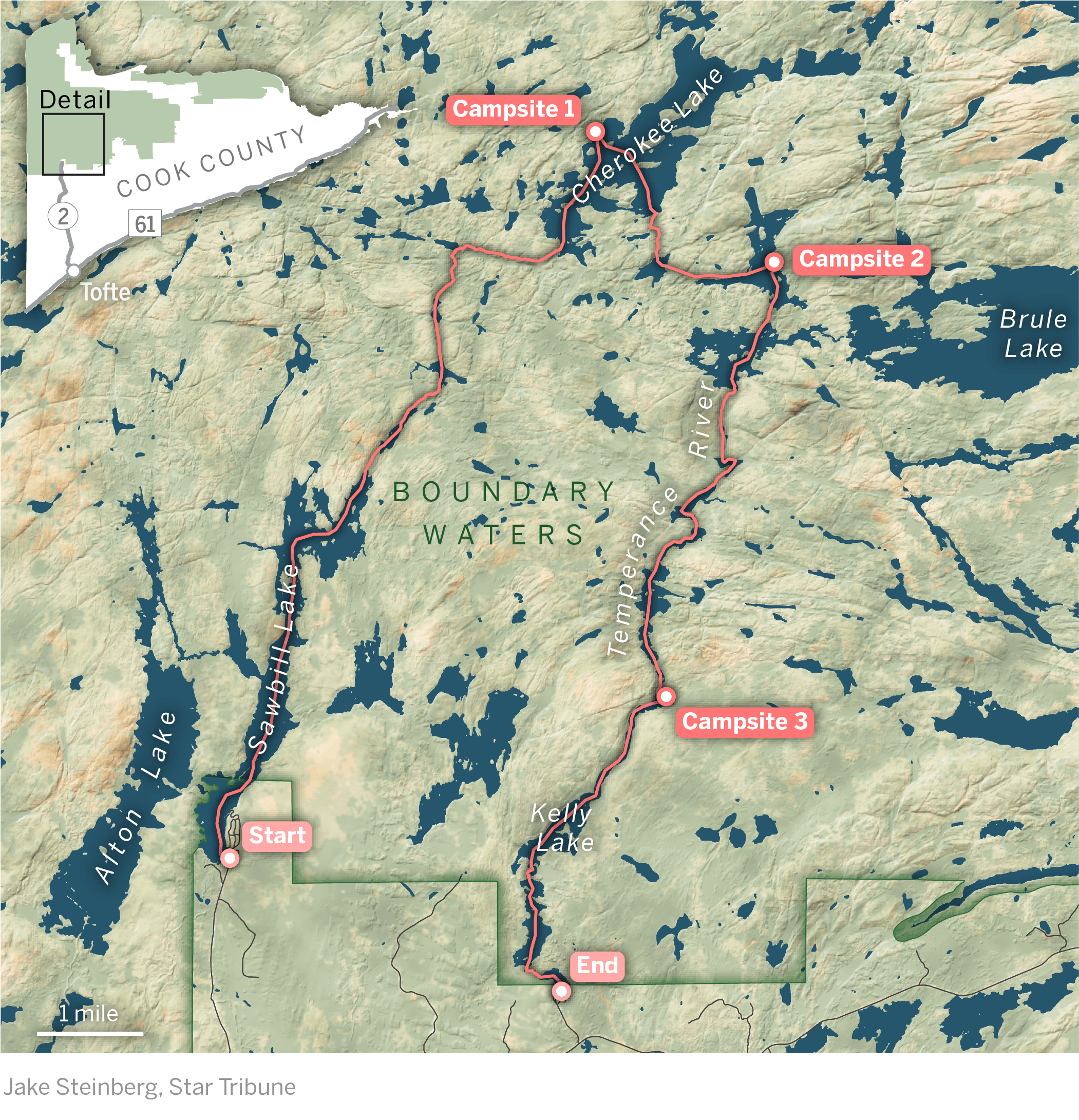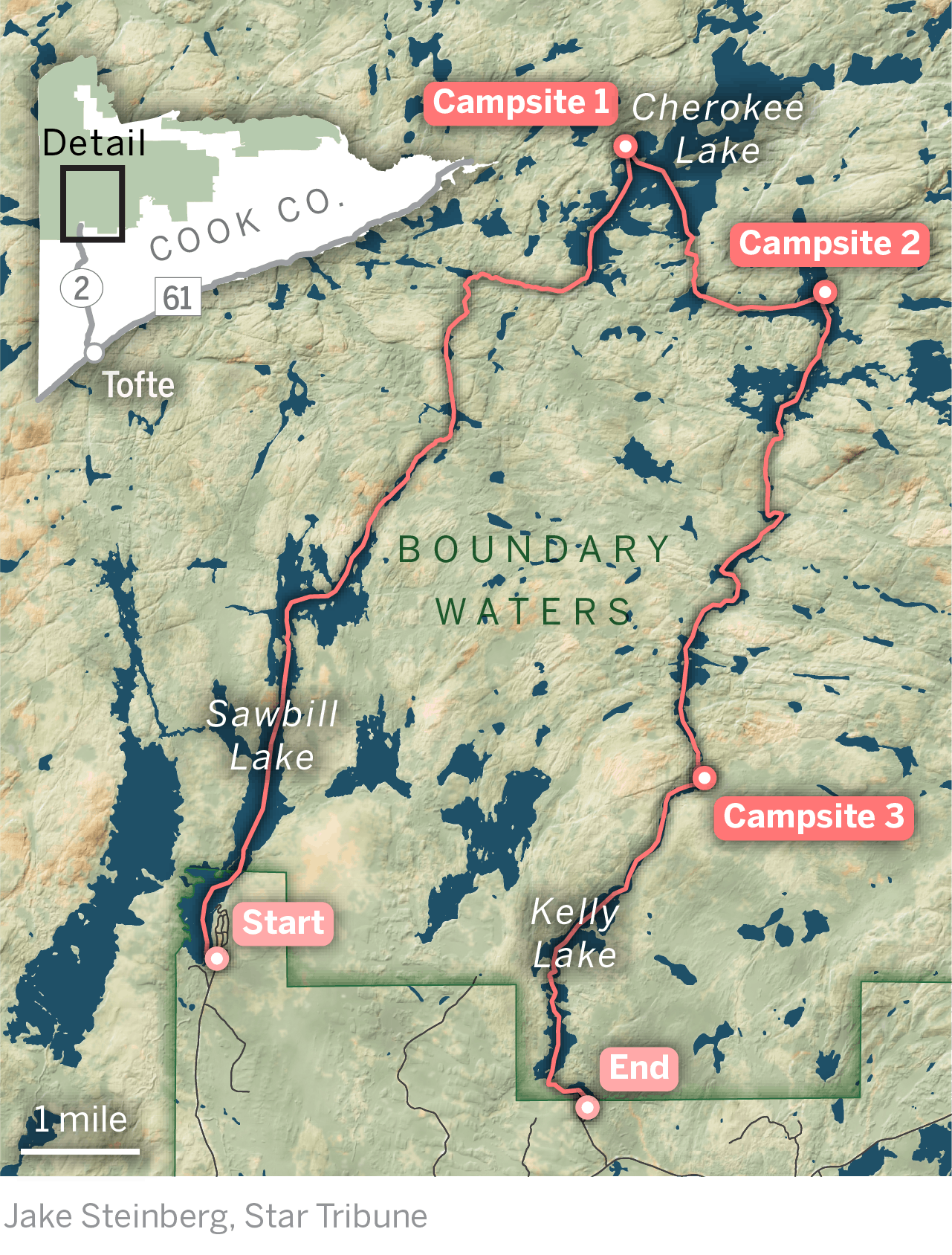IN THE BOUNDARY WATERS CANOE AREA WILDERNESS – From the first pull of the paddle against water, our prospects were better.
The last time my cousin Dan Bielefield and I were together a little more than a year ago, we'd buried my brother in New England.
Mark, who was only 60, wouldn't have found his Zen on a gnarly 140-rod portage, but he'd have appreciated what wild country promises: escape and renewal.
Dan and I had committed to our trip to the Boundary Waters Canoe Area Wilderness in 2022 after honoring my brother's life in west-central Connecticut, where Dan also resides. Now the time had come, after COVID-19 canceled our original BWCA plans in early June.
In mid-September, Dan flew in, and we lit out for the North Woods. He brought gear to contribute (a reliable single-burner stove, a good handsaw and a favorite tarp). More so, he brought experience. A Marine veteran, he had also been a Boy Scout leader for 25 years, with numerous outings on the Saco (New Hampshire) and Androscoggin (Maine) rivers.
We arrived the afternoon before our entry date to the BWCA through Sawbill Lake, near Tofte, Minn., riding out an overnight downpour at the Sawbill campground. We launched into a flat-gray, breezy Tuesday morning. Destination: Cherokee Lake, 8 or so miles north. Like a rail hub, Cherokee offered travel opportunities in multiple directions. We'd built all manner of possibilities into our five-day plan, with one constant: to stay moving.
In the dying light and rain the previous night, after a no-fuss dehydrated dinner under a tarp, we hit the tent and burrowed into our bags early. I had time to consider what lay ahead, and it struck me that our suddenly canceled June trip had opened this door: We were in the wilderness with the seasons in transition. Whereas summer is all about activity — an outward state of mind — fall summons reflection.
On this ancient land, the Ojibwe people's word for autumn — dagwaagin (da-gwaag-IN) — resonated with me for its inclusive meaning. For Native people, dagwaagin is a period of planting and anchoring roots in anticipation of winter. It also is a time for inner growth, to steel against the darker days to come. We don't just notice the days and daylight changing, we feel it. While Dan and I would encounter a few visitors in the days to come, we moved for long stretches in hushed isolation. Peak visiting season in the BWCA was giving way to autumn.
"Maine has the mountains; you have the lakes," Dan said as we pushed over open water and also a channel that we might have walked alongside had the north country not had steady rain in recent months. If the previous night's rain wasn't sign enough, the muddy, boulder-strewn portages were signs that our trip, as expected, would have some texture.
Several hours after our start, we dropped into Cherokee Lake and its 830 acres, with high, granite outcroppings coveted by canoe campers. Our day had been a big calorie burn, and we were itching to find a good site for the night. With daylight draining from the sky, we continued to strike out. If we couldn't yet spot a site from open water, rising smoke above the tree line, telltale of other paddlers' campsites, cued us we needed to keep looking.
Finally, we found a vacancy on a western point. Relieved and spent, we quickly made camp: gathering wood, pitching our tent, hanging a gravity water filter, stringing clotheslines and getting on some dry gear before sundown. A single-pot dinner was ideal fuel for our slumber. Loons kept longer hours, to our delight, piercing the night.
Our campsite came to life in the twinkling morning sun on Day 2. Its warmth restored us after a clear, chilly overnight in the low 40s, and we dried out all manner of gear (socks, canoe packs, shoes), with help from a breeze that stirred through our site.
We paddled on for points east and south and found a good rhythm, abiding by "the time clock of the wilderness" that writer Sigurd Olson so lyrically described. Dan and I began to dial down mentally in our surroundings even while the physical challenge ramped up. Our portage out of Cherokee and over the Laurentian Divide was into small Sitka Lake. We noted later it had an L10 ranking — or Level 10, the toughest — on our Voyageur map. After more than an hour of double-portaging the 165 rods, we'd agreed with the cartographers.


Hours on, most of them spent traveling between water, we came into North Temperance Lake, fed by the river's headwaters flowing from nearby Brule. With few campsites for us to choose from, we settled on an expansive, inviting spot on Temperance's eastern shore. And good thing: We were bone tired.
Later, after a bracing swim to wash off the funk, Dan and I sat, silently, on a perfect perch at the camp's edge. The clouds were moving out and on. So were distant paddlers, silhouetted in late-day sun. Waves lapped. Birds sang. It was all intoxicating after a rigorous day. Nature as healer, indeed.
Like the routines at camp, so much of wilderness travel has meditative qualities. The portages were an acute reminder. "Step by step" was my mantra, and staying in the moment kept me upright. Mindfulness guru Jon Kabat-Zinn, whose books are dog-eared at my house, came to mind: "The whole process of taking a step on rough ground is one of exquisite balance in motion," he writes, "even with the complication of boots and heavy packs. There is a built-in mindfulness here. Rough terrain brings it out in us."
Such a hyper-focus on self often reveals other truths: Dan and I, both pushing 60, got a stark view of our futures in the outdoors. Yes, with all our experiences in the wild, the stresses and joys, our mental game is strong. But we agreed we'd need to boost our physical fitness in the years ahead if we wanted to continue adventure on our terms.
I was two months removed from meniscus surgery. Dan still is hampered at times by a bad back from his military days. We felt both spots midway through our trip and opted to shuttle back to Sawbill from the Baker Lake entry point in a few days rather than loop back to Sawbill, with another L10 portage from Kelly Lake into Burnt, and two less-severe crossings to follow.
Mostly unhurried as our trip went on, with two nights spent on Kelly Lake, I had plenty of time to ponder whether we'd found what Dan and I were seeking by way of canoe. We had escaped the unbroken hum of our everyday lives, and the time dwelling in this beauty, so unchanging and yet transitioning, was a tonic. My grief for my brother and other friends who died unfairly young remains, and always will. But it changes, too.
After Dan and I packed up a final time, we purposefully but slowly glided into Kelly Lake, through lily pads and bulrushes, past windfall on a distant shore, past a bald eagle standing sentry on a spruce 20 yards off, and a kingfisher intent on its path. The trip had been rich in wildlife: the otter that poked through the water's surface to growl at strange visitors. The ruffed grouse we'd spooked more than once on portages. The pile of "moose berries" indicative of the land we were sharing.
We'd been open to all these experiences — and even the final few short portages that delivered us to our Baker Lake landing. Any mud, any misery, Dan said, was inconsequential in light of our whole trip.
By then, dishwater skies had thinned and sunlight signaled the new day. As we shuttled back to the outfitter, grouse hunters were clearly out. It was the opener. Gravel cyclists were on the move, too.
Autumn was arriving in the North Woods.
Dan and I packed up and hopped in the car. There was a proper lunch somewhere on the road home.





